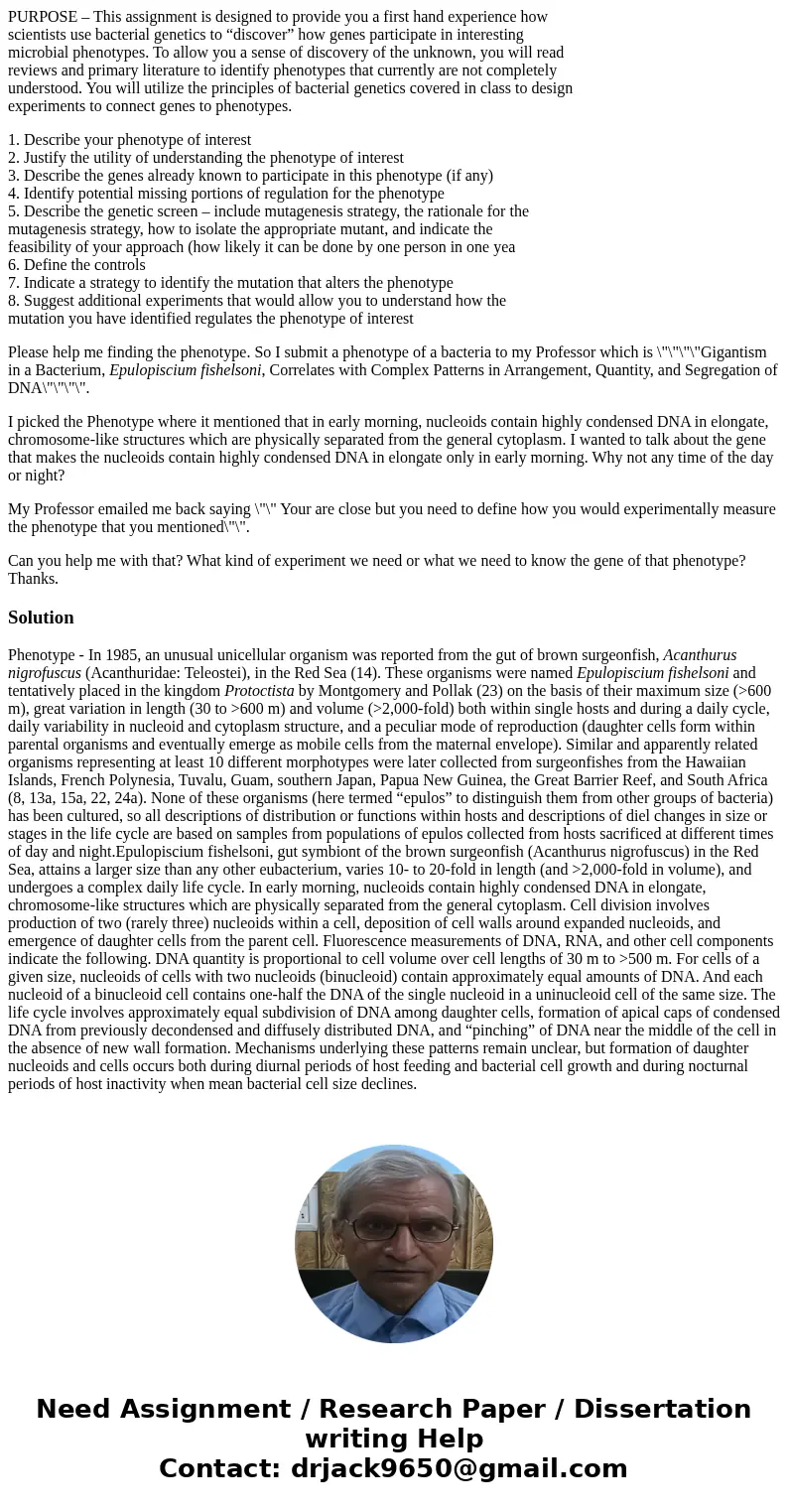PURPOSE This assignment is designed to provide you a first
PURPOSE – This assignment is designed to provide you a first hand experience how
scientists use bacterial genetics to “discover” how genes participate in interesting
microbial phenotypes. To allow you a sense of discovery of the unknown, you will read
reviews and primary literature to identify phenotypes that currently are not completely
understood. You will utilize the principles of bacterial genetics covered in class to design
experiments to connect genes to phenotypes.
1. Describe your phenotype of interest
2. Justify the utility of understanding the phenotype of interest
3. Describe the genes already known to participate in this phenotype (if any)
4. Identify potential missing portions of regulation for the phenotype
5. Describe the genetic screen – include mutagenesis strategy, the rationale for the
mutagenesis strategy, how to isolate the appropriate mutant, and indicate the
feasibility of your approach (how likely it can be done by one person in one yea
6. Define the controls
7. Indicate a strategy to identify the mutation that alters the phenotype
8. Suggest additional experiments that would allow you to understand how the
mutation you have identified regulates the phenotype of interest
Please help me finding the phenotype. So I submit a phenotype of a bacteria to my Professor which is \"\"\"\"Gigantism in a Bacterium, Epulopiscium fishelsoni, Correlates with Complex Patterns in Arrangement, Quantity, and Segregation of DNA\"\"\"\".
I picked the Phenotype where it mentioned that in early morning, nucleoids contain highly condensed DNA in elongate, chromosome-like structures which are physically separated from the general cytoplasm. I wanted to talk about the gene that makes the nucleoids contain highly condensed DNA in elongate only in early morning. Why not any time of the day or night?
My Professor emailed me back saying \"\" Your are close but you need to define how you would experimentally measure the phenotype that you mentioned\"\".
Can you help me with that? What kind of experiment we need or what we need to know the gene of that phenotype? Thanks.
Solution
Phenotype - In 1985, an unusual unicellular organism was reported from the gut of brown surgeonfish, Acanthurus nigrofuscus (Acanthuridae: Teleostei), in the Red Sea (14). These organisms were named Epulopiscium fishelsoni and tentatively placed in the kingdom Protoctista by Montgomery and Pollak (23) on the basis of their maximum size (>600 m), great variation in length (30 to >600 m) and volume (>2,000-fold) both within single hosts and during a daily cycle, daily variability in nucleoid and cytoplasm structure, and a peculiar mode of reproduction (daughter cells form within parental organisms and eventually emerge as mobile cells from the maternal envelope). Similar and apparently related organisms representing at least 10 different morphotypes were later collected from surgeonfishes from the Hawaiian Islands, French Polynesia, Tuvalu, Guam, southern Japan, Papua New Guinea, the Great Barrier Reef, and South Africa (8, 13a, 15a, 22, 24a). None of these organisms (here termed “epulos” to distinguish them from other groups of bacteria) has been cultured, so all descriptions of distribution or functions within hosts and descriptions of diel changes in size or stages in the life cycle are based on samples from populations of epulos collected from hosts sacrificed at different times of day and night.Epulopiscium fishelsoni, gut symbiont of the brown surgeonfish (Acanthurus nigrofuscus) in the Red Sea, attains a larger size than any other eubacterium, varies 10- to 20-fold in length (and >2,000-fold in volume), and undergoes a complex daily life cycle. In early morning, nucleoids contain highly condensed DNA in elongate, chromosome-like structures which are physically separated from the general cytoplasm. Cell division involves production of two (rarely three) nucleoids within a cell, deposition of cell walls around expanded nucleoids, and emergence of daughter cells from the parent cell. Fluorescence measurements of DNA, RNA, and other cell components indicate the following. DNA quantity is proportional to cell volume over cell lengths of 30 m to >500 m. For cells of a given size, nucleoids of cells with two nucleoids (binucleoid) contain approximately equal amounts of DNA. And each nucleoid of a binucleoid cell contains one-half the DNA of the single nucleoid in a uninucleoid cell of the same size. The life cycle involves approximately equal subdivision of DNA among daughter cells, formation of apical caps of condensed DNA from previously decondensed and diffusely distributed DNA, and “pinching” of DNA near the middle of the cell in the absence of new wall formation. Mechanisms underlying these patterns remain unclear, but formation of daughter nucleoids and cells occurs both during diurnal periods of host feeding and bacterial cell growth and during nocturnal periods of host inactivity when mean bacterial cell size declines.

 Homework Sourse
Homework Sourse